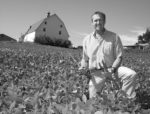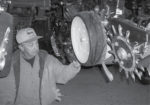Advertise Follow Us
Ron Ross
Ron Ross pioneered the “What I’ve Learned from No-Tilling” series that has appeared in every issue of No-Till Farmer since August of 2002. He authored more than 100 of these articles.
A graduate of South Dakota State University’s agricultural journalism program, Ross spent most of his career as a writer and editor.
ARTICLES
What I've Learned from No-Tilling
Conservation of soil, a better quality of life and the time to invent the TracPacker were all benefits of no-till for Dan Gillespie.
Read More
What I've Learned from No-Tilling
Preserving The Fertile Soils Of The Palouse
Going 100% no-till in 1997 has placed Read Smith in position to help lead the effort to protect the fragile farmland of eastern Washington.
By Read Smith and Ron Ross
posted on
September 1, 2008
| Posted in Cover Crops, Nutrient Management, Seeding & Planting
Read More
What I've Learned from No-Tilling
Fixing Flaws Of No-Till In Infancy Led To Opener
To establish consistent seed germination, New Zealand’s John Baker learned that protecting soil humidity when planting was a critical need with no-till opener designs.
By Ron Ross and Dr. C. John Baker
posted on
June 1, 2008
Read More
What I've Learned from No-Tilling
No-Till Knowledge Gained Through Extension Service
Cover crops, carbon storage and compaction management in no-till systems are just some of the things Alan Sundermeier has researched.
Read More
Boost Profits With Each Spraying Trip
The sprayer is becoming the most important piece of equipment on the farm for assuring top crop yields. It’s the only machine that can protect your profits every time it goes over the ground.
Read More
What I've Learned from No-Tilling
Time and Money Saved allowed for expansion of business operations
We’re now no-tilling four times as much land and have diversified into a grain cleaning and processing operation that works across the country for much of the year.
Read More
What I've Learned from No-Tilling
Get Started Right And Keep Advancing As Fields Change
Deep-slot machine aided the transition to no-tilling, now strip-tilling will help make corn on corn as viable and profitable as possible.
Read More
What I've Learned from No-Tilling
Time Savings Allow for Speciality Crops
High-starch corn and Roundup Ready soybean seed are two crops made possible because no-tilling gives Sam Swinford the time needed for these niche markets.
By Ron Ross
posted on
May 1, 2007
Read More
Top Articles
Current Issue
No-Till Farmer
Get full access NOW to the most comprehensive, powerful and easy-to-use online resource for no-tillage practices. Just one good idea will pay for your subscription hundreds of times over.
Soil Health Principle 4: Continual Living Plant
Regenerating Your Profits: No-Till, Covers & Livestock
Good or Bad, We’re in for Some Interesting Times for Conservation Ag
Must Read Free Eguides
Download these helpful knowledge building tools
- How Beneficial Insects, Pollinators Can Boost No-Till Resilience
- How No-Till Improves Your Land Value
- 5 Pillars for No-Till Farming Effectively, Efficiently
- Making the Precision Basics Even Better with Implement Guidance
Videos
Farmer Shares Formula for Better No-Till Corn Emergence
On this episode of Conservation Ag Update, brought to you by Yetter Farm Equipment, longtime no-tiller Ross Bishop shares some of the keys to achieving even corn emergence with no-till.
Events
Conservation in Action Tour 2025 -- Sioux Falls, S.D.
Date: 05/06/25
Location:
View Event
Top Directory Listings
Needham Ag Technologies, LLC
Needham Ag understands the role of technology in making better use of limited resources within a specific environment by drawing on a wealth of global experience to overcome the challenges facing today's farmers, manufacturers and dealers.
Titan International, Inc
Titan offers a full line of wheels, tires and undercarriage products for a wide variety of off-the-road equipment.
The Andersons PureGrade
The Andersons grows enduring relationships through extraordinary service, a deep knowledge of the market, and a knack for finding new ways to add value as we have done for nearly 70 years.
















